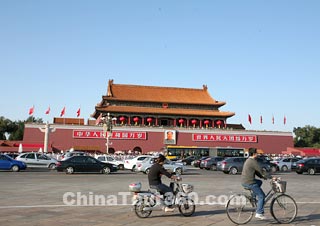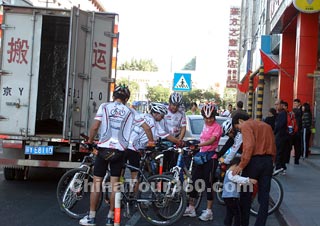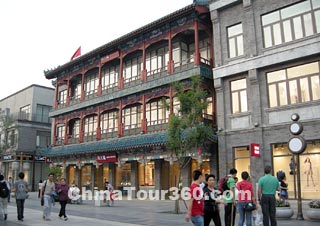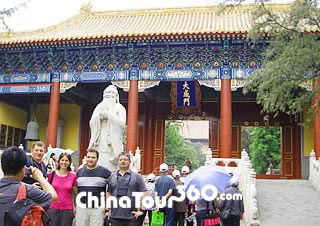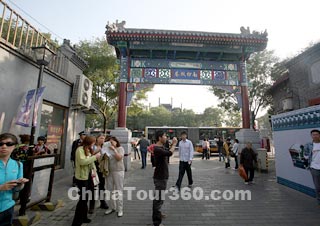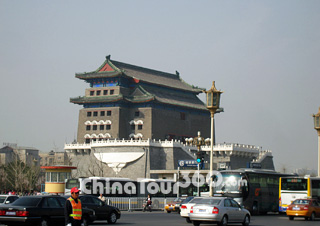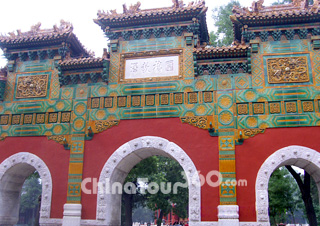Beijing Bike Tour
"Hutong Bike Route"
- Code: BK03
Biking is becoming more and more popular among the travel fans. Taking a bike tour in the cities, you could have more flexibility on time arrangement and could get to know more about the local people and their life. At the same time, it could help people keep fit and healthy.
Today we will guide you to take a bike tour around the Hutongs in the city. The whole journey is about 30 km. Beijing folks say: Beijing has 3600 famous Hutongs and has innumerable Hutongs without name. Hutong is the cultural characteristics of Beijing, as well as the root of Old Beijing. To experience the Old Beijing, Hutong tour is a must. The best way to visit Hutong is by bike.
Where to find a bike? You do not need to buy one. There are many places offering the bike rental service. Here are some suggestions.
1. Nan Hai Qian Yan near Shichahai. The rent for a single bike is CNY10.00 net per hour and it is CNY20.00 net per hour for a tandem if two persons ride together. The shop keeper will require a deposit of CNY500.00 net per bike.
2. Ban Chang Hutong – just on the opposite of Lusongyuan Hotel. The rent is just half of the previous one and the deposit is CNY300.00 net per bike.
3. Qianmen Street - on the opposite of Quanjude Restaurant. The rent is the cheapest one – CNY20.00 net per day.
|
|
The starting point of your bike tour is Tiananmen Square, which is located in the city center and is the largest city square in the world – 880m in length and 500m in width. It is surrounded by many famous sites. You could have a visit of them at the same time. The Monument to the People's Heroes stands in the middle of the square. To the north, it is Tiananmen Tower under which you could go inside the famous Forbidden City. The Great Hall of the People and the National Museum of China stands in the west and east side of the square respectively. The Chairman Mao Memorial Hall and Zhengyang Gate Tower are situated in the south of the square. Nowadays, thousands upon thousands tourists visit Tiananmen Square everyday.
Starting from Tiananmen Square, riding to the south until Zhengyang Gate, turning left, heading to the east and riding along Qianmen East Street for about 5 minutes, you will find a big cross and arrive at Qinian Street, where you are advised to turn right and continue riding. The first stop is West Damochang Hutong. In the Ming Dynasty, groups of stonemen came from the suburb and lived between Qianmen and Chongwenmen, forged and grinded stones for the Palace and the nobles. Gradually, there were more and more stonemen coming here. Thus the name of Damochang Street was born. Various kinds of stores were available here such as blacksmith's shop, musical instrument store, hostels, restaurants and so on. It was very booming and prosperous at that time. But as time went by, it got into depression for many reasons.
|
|
Continuing your bike tour and riding to the west – less than 500 meters, you will arrive at Beixiangfeng Hutong, originally called Qiangfeng Hutong (meaning the slot on the wall), as it is too narrow. The narrowest part is only 0.5 meters. Speaking of Peking Roast Duck, most of people will think of Quanjude or Dadong restaurant. While there is restaurant offering the same quality or even better roast duck in this Hutong, named Liqun Roast Duck Restaurant, which was recommended in Lonely Planet and was even on the cover of Time. The boss as well as the cook Mr. Zhang Liqun worked in Quanjude Restaurant for some time and then he opened his own restaurant in his house. The main guests here are coming from Europe and America. The wall of its aisle is covered by many photos which show many foreign dignitaries ever ate here. You could have lunch here to taste the roast duck if feel interested.
Out of Beixiangfeng Hutong, riding towards north and passing through Qianmen East Street, you will get to Dongjiaominxiang – the longest Hutong in old Beijing, about 1552 meters. This street was the embassy area in old China and the buildings were kept in European style as they were. Now, you could see the buildings of former French Embassy, Austrian Embassy, Belgian Embassy, Japanese Legation and Embassy, Italian Embassy, British Embassy, Citibank, Yokohama Specie Bank and International Club. Some of them were changed into other institutes afterwards. The Dongjiaominxiang grade school is the former Romanian Embassy. The Beijing Police Museum is the former Citibank which is called Huaqi (multicolored flag) Bank by the Chinese until now, as when this bank was opened in China, there was a national flag of United States hanging in the front of the bank everyday. Since there are many government offices in this Hutong which are not allowed to take photos, please pay attention to the remark on the wall before taking photos. You could find a two-floor Gothic architecture in this lane, which was the St. Michael's Church – famous for the elegant angel statue at its main entrance. It is a cultural heritage and is one of the few Catholic churches in Beijing which has not been destroyed completely and reconstructed.
|
|
The St. Michael's Church locates at the cross of Dongjiaominxiang and Taijichang streets. Ride to the north from Taijichang Street until arriving at Dengshikou Street. Then heading to the west, passing through Dengshikou West Street and riding along Beiheyan Street, you will arrive at Di’anmen Street. Continue to the north along Xinjiekou South Street. We will get to the next destination which has a very fancy name – Baihuashenchu Hutong meaning ‘at the depths of various flowers’. In the Ming Dynasty, an industrious and frugal couple bought about 2 hectares open space in the small lane south of Xinjiekou to grow various kinds of vegetables for living. Later on, they planted peony, plum blossoms and chrysanthemum, and grew lotus in the pool. People could see different flowers during the whole year. A large group of writers were attracted to admire the beauty of flowers here frequently. Then the name of ‘at the depths of various flowers’ was coming. In the Qing Dynasty, the garden was abandoned and this area was becoming street gradually. But the name retained. About 10 years ago, here was the base of the musicians, and there were many recording rooms. The most famous one was Baihua recording room, where lots of rock music was created. Now, you could only see the remainders.
Ride to the east along Baihuashenchu Hutong and move towards north after passing through East Huguosi Street until Sanbulao Hutong. Then go to the east along Sanbulao Hutong to Deshengmennei Street and continue riding towards the north and turn to the east along Yangfang Hutong to Houhai Nanyan. Crossing over Houhai and Yandaixiejie, you will see the Drum Tower. Behind it is the Bell Tower. They were built in the Yuan Dynasty and were used to giving the correct time in the Yuan, Ming and Qing dynasties. As time passed by, they were destroyed and rebuilt for many times. The Bell Tower we see today was built in the Qing Dynasty and the Drum Tower was built in the Ming Dynasty. In the east of Drum Tower, there is a very famous snack bar – Yaoji Stewed Liver Restaurant offering various kinds of local snacks. It is said that the vice president of America Biden had some snacks in this restaurant when he visited China.
|
|
After refreshing, you can set out to the east along East Drum Tower Street and turn to the north at Andingmennei Avenue. The fifth street you will see is the Guozijian Hutong, which was named because the famous Guozijian locates here. This is the only street with four decorated archways in Beijing. Guozijian built in 1306 in the Yuan Dynasty was the highest administration supervising education as well as the national highest institute in the Yuan, Ming and Qing dynasties. It was used as the National Library and Beijing Young Folks Library from 1949 to 2003. Next to the east side of Guozijian is the Confucian Temple, which was the place to offer sacrifices to Confucius in the Yuan, Ming and Qing dynasties. It is considered as a holy place with nimbus. Thus, many students come here to pray for good luck before the college entrance exam. There are also many special boutiques in this street. You could visit then leisurely.



